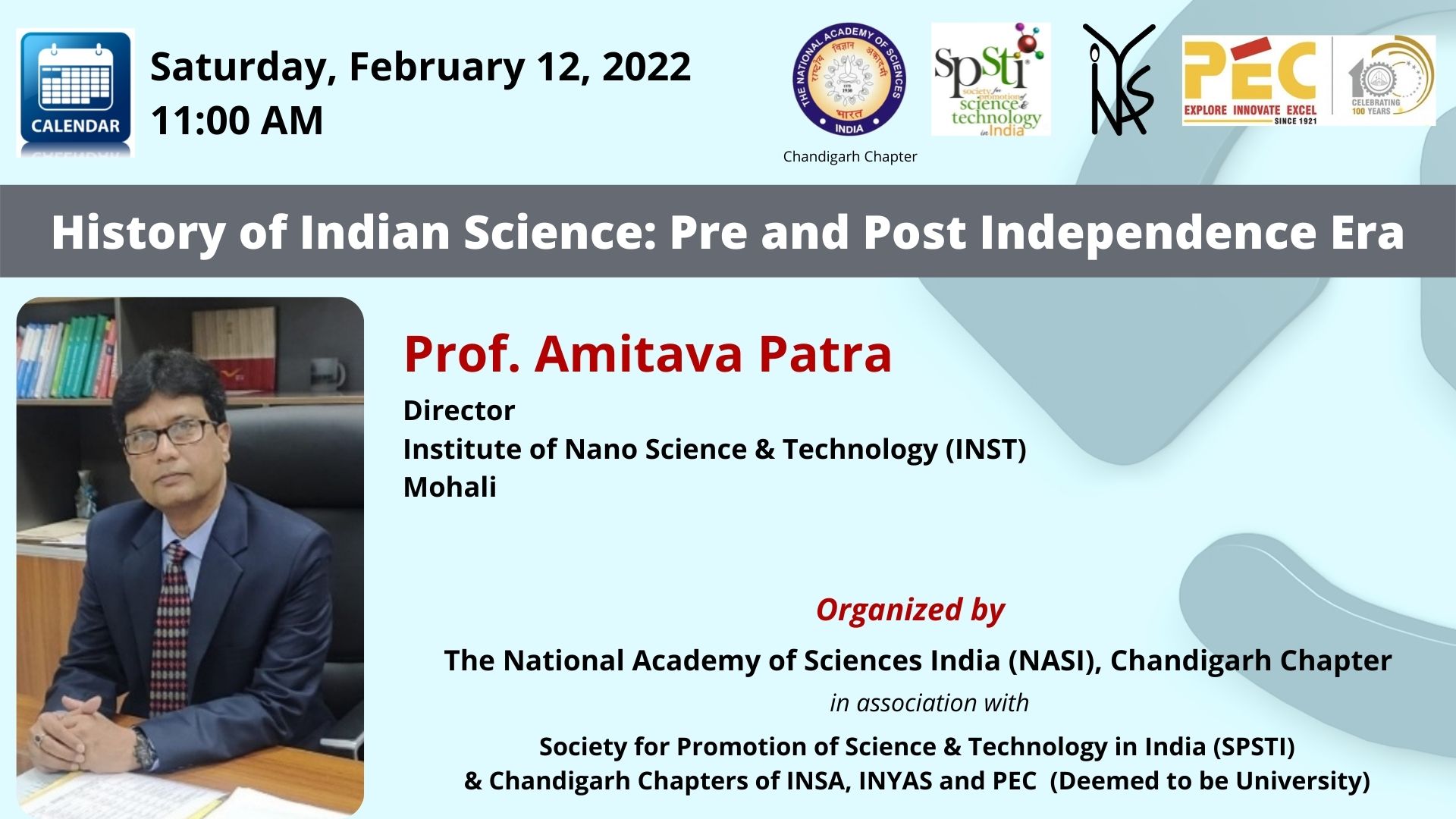History of Indian Science is important and helps to critically examine the past institutes and lessons learnt from them for building new institutes for the benefit of Science in India. This important topic was discussed and a lecture delivered by Prof. Amitava Patra, Director, Institute of Nano Science and Technology (INST), Mohali, in an online webinar organized by the Chandigarh Chapter of the National Academy of Sciences India (NASI) and presented by the Society for Promotion of Science of Science & Technology in India (SPSTI), in association with the Chandigarh chapters of INSA & INYAS and Punjab Engineering College (PEC) (Deemed to be University), Chandigarh. It was the first Lecture in series initiated by NASI Chandigarh Chapter to commemorate Azadi ka Amrit Mahotsav. The lecture was delivered on February 12, 2022 at 11.00 am through online mode. The session was attended online on zoom and many more viewed the same on the Facebook page of SPSTI.
Prof. Amitava Patra, Director, INST spoke about History of Indian Science and lauded the role of several eminent scientist whose contributions in building ecosystem in Indian Science and research are well known. He started the session with tracing the progress of science over centuries with the discipline of‘Physics’ coming into existence in 17th century to Chemistry in 18th century to biology in 19th century. Modern Science took roots in India during the British Colonial rule, when the stalwarts contributed their services equally to the society and science. Survey of India was the earliest ‘scientific’ institute in the 19th century. Slowly other institutions were established in 1857, the first three Universities (Calcutta, Bombay and Madras) were established in India, but they did not have Science disciplines, nor research. Subsequently, Prof. Ashutosh Mukhrjee, the vice chancellor of Calcutta University brought in teaching of science subjects and finally research. Meanwhile Indian Association for Cultivation of Science (IACS) was established in Calcutta in …. for bringing science to the masses. Subsequently, C. V. Raman joined the institute and did his famous experiments on light scattering which fetched the Nobel Prize. Sir Ashutosh was the first Indian to publish research as well as awarded dual degree and served as the vice president of IACS. IISc Bangalore, a premier institute for research, was established in 2014.
Prof. Patra recounted the major contributions made by Indian scientists pre-independence, which include works of Sir JC Bose, Prof. C.V. Raman, Prof. S.N. Bose, Prof. P.C. Roy, Prof. SS Bhatnagar and Prof. M. N. Saha. JC Bose was the inventor of first solid state diode and he also developed the first instrument to record bioelectric signals in plants, which had a global impact. He has not only contributed to research in Science but has also built Bose Institute. Prof. C.V. Raman, published his first paper at an age of 18 and went on to become the first Asian to win Nobel Prize. Quoting Raman Prof. Patra said,“Indian mind is not inferior, it is we who lack courage, which needs to be unfolded”. S. Ramanujan, very famed for his contributions in number theory, known for the theta function named after him, also lived in those times. Prof. Meghnad Saha is known for his contribution in astrophysics and electromagnetism and was the first director of IACS and also founder of Saha Institute of Nuclear Physics, Kolkata and Indian National Science Academy. Prof. Saha also founded NASI at Allahabad and Indian Physical Society in Kolkata. Prof. S.N. Bose is well known for his work in quantum mechanics and the fundamental particles, Bosons, were named after him. He worked with both Madam Curie and Einstein. The Chemistry research in India started with Prof. P. C. Roy, who is also known as father of chemistry in India. His main contribution in chemistry was in metal nitrides. In 1901, he had started the first pharma company, Bengal Chemicals and Pharmaceuticals and also founded the Indian Chemical Society.
Technical education Institutions, including IITs, NITs, etc., were established in the country post independence, to reform Indian education, science and technology. Several science and education policy documents by Indian government have been released, the latest one being the new education policy. The three national science academies in the country provide a common platform for scientist to discuss science, policies, and advise the Government.
The stalwarts of Modern science in India include Prof. Homi Bhabha, Dr. Vikram Sarabhai, Prof. S.S. Bhatnagar, Prof. Sambhunath De, Prof. G.N. Ramachandran, Prof. Janaki Ammal, Prof. Birbal Sahni and Prof. A.P.J Abdul Kalam.
Following the talk, a deep discussion ensued during the Q&A session, wherein it emerged that the level of autonomy for scientist and institutions enjoyed by Indian scientist pre-independence era has led them to contribute significantly in Indian Science, and same is required in current scenario along with participation of society. He at the end also emphasized upon the need of skilled human resource and infrastructure for scientific progress of our country.
Earlier, the speaker was introduced by Dr. Pooja, Pr. Scientist, CSIO, and Member INYAS, INSA. Prof. Grover gave the opening remark and rational behind this series being organized by NASI Chandigarh Chapter in collaboration with other academies Chandigarh Chapter. The session was much appreciated by the audience and followed with intense discussions and questions. Shri Dharam Vir, IAS (Retd.), the President of SPSTI presented the vote of thanks. Others present on the occasion were Prof. R.K. Kohli, President NASI CH Chapter, Prof. Rajinder Singh, Prof. Keya Dharamvir, General Secretary, SPSTI, Ms. Rajni Bhalla. Prof. Arun Kumar Grover, Former Vice Chancellor of Panjab University and Vice President of SPSTI.

